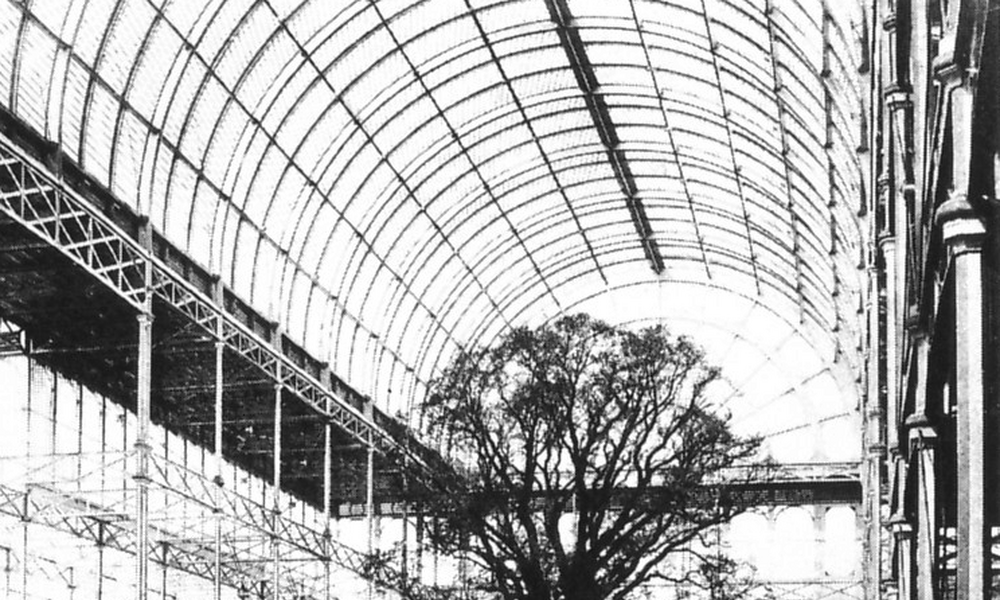The new Crystal Palace: Populism and Digital Democracy

On the occasion of the group exhibition Open Skies at WIELS (27.9.2019–5.1.2020), Passa Porta invited two young Belgian authors to write a new text in which they present a critical reflection on the ever-louder call for transparency in society. Below you can read the essay by the Brussels-born Dutch-language philosopher Anton Jäger.
A civilizational ideal made out of glass
On 9 July 1862, the Russian writer Fyodor Dostoevsky made landfall in London. ‘What a terrifying city’, he immediately wrote home. ‘The devil reigns; ‘the suffering, the crying and the lethargy resound through its lanes’; and ‘it’s none of anyone’s business’. Everything in the city was so ‘huge and abrupt in its individuality’, while in the streets, ‘a struggle to the death’ was being waged between the ‘individualistic basis of the West and the necessity of somehow getting along with each other, of somehow putting together a community.’ ‘The poor are not even allowed into the church’, a disconcerted Dostoevsky observed, ‘because they have nothing with which to pay for a place on the bench.’ London was pandemonium.
Dostoevsky had indeed chosen an unfortunate moment for his English visit. The capital was in the midst of one of the most dramatic upheavals in human history – the Industrial Revolution. Workers and whores roamed the streets, while the slums of East London were blanketed in clouds of smoke from the factory districts. The rich had entrenched themselves in imposing villas in the suburbs. ‘They go’, Dostoevsky observed, ‘all over the earth, penetrate into the depths of Africa to convert a single savage and forget about the millions of savages in London who have nothing to pay them.’
Dostoevsky’s visit to London took place ten years after the Great Exhibition of 1851. One building in particular at the exhibition was the most powerful symbol for his nightmarish introduction to the capital. The so-called Crystal Palace stood out in the heart of the exhibition site, built by British workers in the previous decade. The gigantic structure was designed specially for the exhibition in order to demonstrate the ingenuity of the British engineers to international visitors. The building was almost entirely financed with public funds, collected under the supervision of Isambard Kingdom Brunel, the most famous engineer of his day. A competition had been organized and an international consortium of architects had submitted proposals.
The winning design was that of landscape architect Joseph Paxton, famous for his bourgeois gardens and parks. The choice was not surprising. For many years, England had been the land where aristocrats could undertake vast building projects on their estates, in part thanks to exclusive property laws. Paxton imagined the Crystal Palace on the basis of those models: a large greenhouse in which the growth of humanity could be measured out beyond its natural borders, a monument to progress. The Victorian construction was an ideal of civilization made out of glass. It was packed full of art and curios for the exhibition, from Mediterranean painting to ceramics and local craftwork. Portraits from 1851 shows a public of men in felt hats and women in corsets, flanked by scientists and experts. They all stare in wide eyed wonder at the artefacts.
At the end of that long, parallelogrammical palace stood a stately oak tree, which had been replanted there for the occasion. The exhibition as a whole underlined the evolutionary undertone of the project. Just as nature was bursting at the seams, England was stretching its arms out around the entire planet, with ships, factories and canals, maps and trading posts.
A year after the exhibition, the entire construction was transferred to the London district of Sydenham, where it was opened to the public. The construction would be in use therefore about another century, before it went up in flames in 1936. The fire was visible from far in the countryside. The moment was also symbolic. The great bourgeois civilization of the nineteenth century was coming to an end. Winston Churchill even spoke of ‘the end of an era’.
Transparency as a bourgeois view of life
The meaning of the Crystal Palace was immediately clear to observers of the day. ‘The longing for purity and clarity’, a German visitor wrote in 1851, ‘for immaterial levity and unending liveliness, is fulfilled in this glass – the most unspeakable, the most elementary and the most flexible of all building materials’. That also rendered the palace intrinsically modern, and explains Dostoevsky’s dislike. Later, in his Notes from Underground, he would ramble on about the meaning of the construction. ‘You believe’, says the protagonist, ‘in a crystal edifice, forever indestructible; that is, in an edifice at which one can neither put out one’s tongue on the sly nor make a fig in the pocket.’ As an embodiment of total visibility, Dostoevsky’s protagonist is ‘afraid of this edifice precisely because it is crystal and forever indestructible’. And even though ‘the crystal palace is a bluff … by the laws of nature it should not even be.’
The political implications of Dostoevsky’s reading were also clear. The palace served as a metaphor for the British nation. It represented openness, enlightenment and progress, but above all transparency. ‘Once the world had been changed into a large greenhouse’, German philosopher Peter Sloterdijk claimed in his book The Crystal Palace (2006), into ‘a vast imperial museum of culture, the [crystal palace] revealed the contemporary tendency to domesticate both culture and nature.’ ‘Diffuse boredom and unspecified stress’ were the ‘universal values’ of this ‘life in a greenhouse’. Transparency was not only an architectural value, but also confirmed for the bourgeoisie an entire vision of life, from architecture to the economy and politics.
The clearest representation of this transparency was the British parliament. It was not only the centre of British decision-making. It also represented a clearly defined ideal of openness, in which the bourgeoisie could discuss its affairs without royal discretion or court intrigues. Victorian philosophers frequently represented the parliament as ‘a mirror held up to the nation’, an image that could be evoked to settle arguments without broadening voting rights. That stood out against the discretion of absolutist rulers whom Dostoevsky extolled. The Court in St Petersburg was not transparent, as the scandals involving the mystic Rasputin in the years before the October Revolution of 1917 would show. But it did preserve the cosmic and social order instead of the openness that was so openly acknowledged everywhere in the United Kingdom: beggars in the street, priests in their churches, whores in their alleyways. Everything was unbearably transparent.
Leftist parliamentarism
The predilection for transparency in the nineteenth century was no exclusively liberal prerogative. On the left too, the British House of Commons was long regarded as an ideal political organ. Precisely because of its open debating culture, transparent procedures and flexible legal structures, it offered an elegant shortcut to an administrative body that communists could also mobilize. Socialist politicians such as Karl Kautsky and Friedrich Engels therefore often modelled their vision of a revolutionary committee on the House of Commons. ‘I cannot imagine’, Kautsky wrote in 1898, ‘any other dictatorship of the proletariat than a socialist majority in the British parliament’.
The twentieth century acted on this desire for transparency. When socialists achieved their first victories after the First World War - European politicians gave the working classes the right to vote after the slaughter of 1914–18 – they saw their main task as parliamentary. The index, social security and unemployment benefits were all introduced in Belgium by parliamentary majorities. The SDP in Germany was soon regarded as the party of ‘parliamentarianism’. When the German jurist Carl Schmitt launched his attack on parliament in the early 1930s, he was aiming primarily at the SPD. ‘Parliamentary power’ was synonymous with ‘socialists’. This was in contrast to the circles around the army, courts and emperor, which were still secret. Openness and social progress seemed to go hand in hand.
Pillarization and resistance
The European Left’s parliamentary romance did not last long. After fascism, the majority of the welfare state was developed precisely through an extensive bureaucracy and executive departments. They populated the chambers of de-pillarization. From the 1960s onward, both on the left and on the right, dissent grew against this ‘new class’ of civil servants who treated the public sector as their private hunting ground.
In this way, experts – whether in education, the arts or science – were put away as old clerks. These had fused with the pillars and populated the high towers of the state. Aversion to the pillarized society and the celebration of a new transparency was openly professed in Guy Verhofstadt’s ‘Citizen Manifestos’ (1991), in which he combined a predilection for new entrepreneurship with a hymn to technocratic policymaking. Verhofstadt spoke of ‘bastions spread across society’, ‘massive pillars on which the Flemish community has built its roof’. These were ‘high skyscrapers in which an ordinary citizen can walk around all his life’, with endless corridors. And this ‘without ever having to step beyond his ideological milieu and reach his social “satisfaction”: school, trade union, hospital, health insurance, savings bank, housing agency, cultural fund, stamp money, subsidized holidays, appointment …’
Such criticism was not exclusive to the right. In the late 1970s, the French philosopher Michel Foucault became equally concerned about the ‘disciplinary’ and ‘normative’ aspects of the welfare state. Indeed, he believed it rested too heavily on a particular view of humanity, an ideal median, thus repelling outsiders or making transgression impossible. In the 1980s he hoped to transform the welfare state into a ‘large experimental plateau’ where ‘thousands of discourses would proliferate’. He contrasted this with the ‘disciplinary’ treatment that people had previously undergone in the welfare state, where they were observed, measured and judged by doctors and social workers, the personal eyes of the impersonal state.
After all, things could be so different. The California that Foucault had visited in the early 1970s had already found an elegant way of reconciling authority and permissiveness. As Foucault wrote, ‘homosexuality and capitalism coexisted surprisingly well here’. In the 1970s he declared the ‘end of the revolution’ and hoped that certain forms of ‘counterconduct’ would gradually create new spaces for emancipatory practices. This could happen alongside the old institutes of states, parties and trade unions. At the same time, the British engineer Stafford Beer designed in Chile a primitive version of the Internet, which allowed socialists to send in proposals via television and citizens to give their consent with the aid of remote devices. Representative democracy had to be eliminated, but it would make possible a higher form of popular participation.
In the same way, Pim Fortuyn later opposed unnecessary filter mechanisms between citizen and state in the Netherlands. ‘His house’, as the philosopher Dick Pels once indicated, ‘had to be a glass house, transparent and accessible to everyone’. Fortuyn sang the praises of the new crystal palace of this populism in his book Het zakenkabinet Fortuyn (1994): ‘How nice it would be if … the Palace on the Dam Square were to be thrown open to the people to become a centre of vibrant activity, for art with a capital A, but also for André van Duin, Paul de Leeuw or a pop group – a palace where Dutch identity would fully take shape. And what a beautiful thing it would be, public persons serving, to a certain extent, as public property. People we can get to know, how they live, in short, our people.’
The restricting institutions between individual and state had to be reformed. Citizens had to take to self-management. This would increase the transparency of social life and eliminate the backroom politics of pillarization. Verhofstadt proposed a strong central bank, periodic referendums and an American-style Supreme Court. Fortuyn, on the other hand, wanted to abolish the minimum wage and render the labour market more flexible, so that people could easily be transferred from one workplace to another. Above all, the state had to become more transparent.
The rise of techno-populism
With their idiosyncratic combination of populism and technocracy, both Fortuyn and Verhofstadt embraced a general trend. In the 1990s, figures also appeared in Italy, the United States and France who sought to replace the old party democracy with a more transparent organization. For two decades Silvio Berlusconi controlled Italian politics with his media empire. His ‘telepopulism’ offered citizens direct access to his actions on television, a passive form of supervision that would give citizens power over the state. Beer and Foucault hadn’t imagined it this way.
Tony Blair undertook a similar operation within Labour. He cut ties with the trade unions, gave power to the British regions and worked eagerly on European integration. He relegated the term ‘class’ to the wastebasket of history. Instead, he preferred the term ‘people’. After the death of Diana the ‘people’s princess’, for example, he evoked a period of national mourning as a collective trauma that transcended all classes. Here too, transparency was honoured. Social security was digitized, public services were replaced by private providers and the National Health Service set up internal markets for its medicines and surgery. This was meant to increase the transparency of the system and at last engage the citizen in the state once more.
Nevertheless, the ‘divide between the citizen and politics’ remained far from being closed. Votes in favour of the Front National in France, the British National Party and Vlaams Blokin Belgium spoiled the party of the liberal and social-democratic parties. All of them pointed to an unease in the new transparency and the de-pillarized civil society. In 2005 the European constitutions were rejected in France and the Netherlands. For many, the rejection was seen as a popular ‘nyet’ against a heavy bureaucracy that had become detached from political control. But how would the gap ever be closed without giving up the old ‘governability’?
Digital democracy
For a long time, the Internet seemed to offer solace. With its free access, playful rules of play and flexible function, it was the ideal platform for a society whose ties with the state had been severed. Parties were losing their members as churches were losing churchgoers, while the trade unions surrendered their privileges. Citizens could now express their opinions elsewhere. In 1994 the American magazine The Baffler already spoke of ‘the opening of a new digital border’, the continuation of the old American colonies in the West. Now that all markets worldwide had been braved and profit margins were shrinking, a brand-new continent was opening up: the human brain. The world of the web most resembled that free space, the forum for an age in which the public sphere was getting ever narrower. Soon it was taken over by large media groups and news companies. But for a while, the new transparency seemed to live up to its promises. The first wave of the Arab Spring was announced on Facebook. Protesters and strikers were drawn to squares with smartphones where the crowd demonstrated against its dictators. New networks prepared the overthrow of regimes.
Ten years later, the landscape looked radically different. In almost every country, the Arab Spring had ended in civil war or repressive regimes. Emmanuel Macron and other liberals looked for ways to curb the proliferation of ‘fake news’ at all costs, from the ‘yellow vests’ to the flourishing alt-right. The Internet created new communities but did so without any proposed signposts. The digitization of democracy and the trimming of the institutions between citizen and state in favour of more direct representation turned out to be tactics that worked better for the far right than for the centre. Matteo Salvini commands no fewer than three million followers, who stay informed of his doings on a daily basis. His Instagram page is cared for with surgical precision. Just like Theo Francken, he is in direct contact with his followers: he answers their comments (‘easy, lads!’) or urges them to give their own input (‘let me know what to say!’). Tactics that we mainly associated with classical antiquity – think of the approving thumb that was once used by Roman emperors – seem to have come back from the dead.
Neoliberal dreamworlds
Neoliberalism has never really been able to enforce its total transparency. For the most part, economic policy is still being decided in small circles, in central banks and commissions. Rating agencies consisting of a single person determine the creditworthiness of entire nations. Policy is a matter for cabinets. The pitiful debating culture of the Belgian parliament is only one of many examples of the decline of parliamentary power. If there is one thing that has eroded neoliberalism, then it is the parliamentary dimension of democracy. Parliaments have become switch rooms where technocrats come to deliver their demands and the work of the opposition has become an irrelevance. Instead of representing the people to the government, parliaments represent the government to the people.
And yet a profound desire for transparency lurks in the neoliberal ideal. Any Apple store is the best example of this: a large, open space that grows with the public sphere but is still designed for unbridled consumption. The word ‘temple-like’ is often used in this context. The London Shard – Boris Johnson’s crown jewel during his time as mayor – offered the same transparency, a great illusion of glass in which the City saw its money flows reflected. Unsurprisingly, it was it once compared to the Crystal Palace of 1851.
Translated by Patrick Lennon
Anton Jäger (b. 1994) obtained an MPhil in intellectual history at Cambridge University, where he is currently pursuing a PhD on populism in the United States. He also studied politics and philosophy at Essex. He writes for De Groene Amsterdammer, De Morgen, Sabzian, rekto:verso, Apache, Lava, DeWereldMorgen.be, Jacobin and The Guardian.
More info on Open Skies at WIELS:


